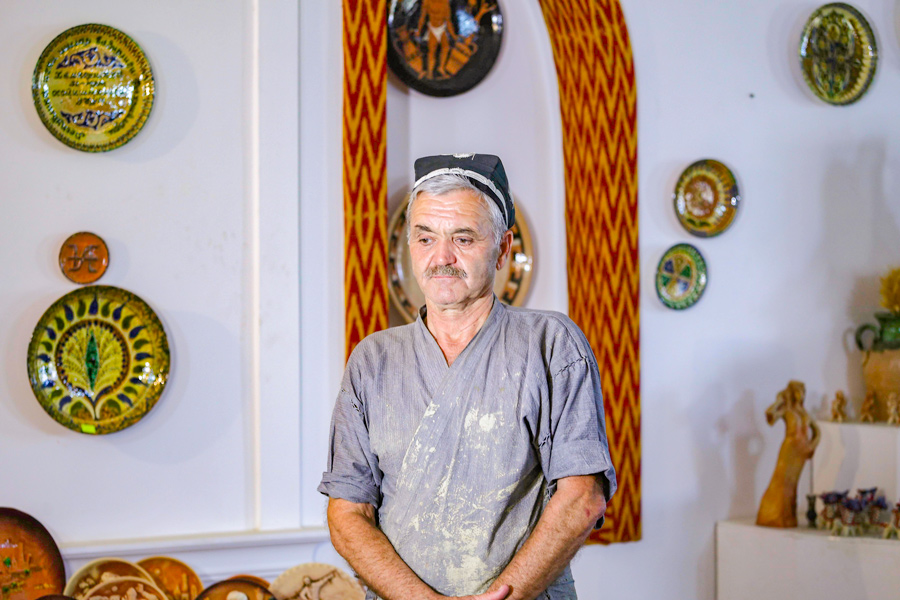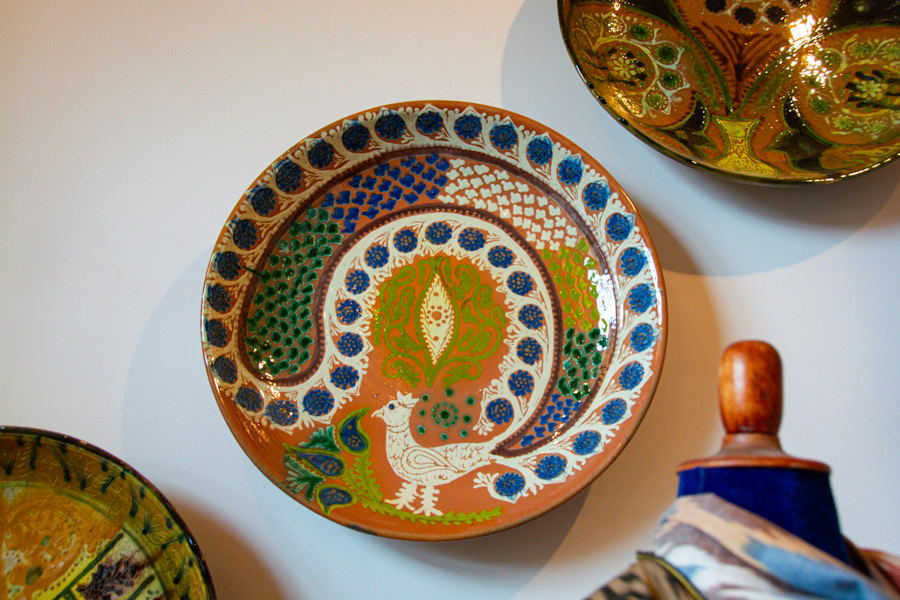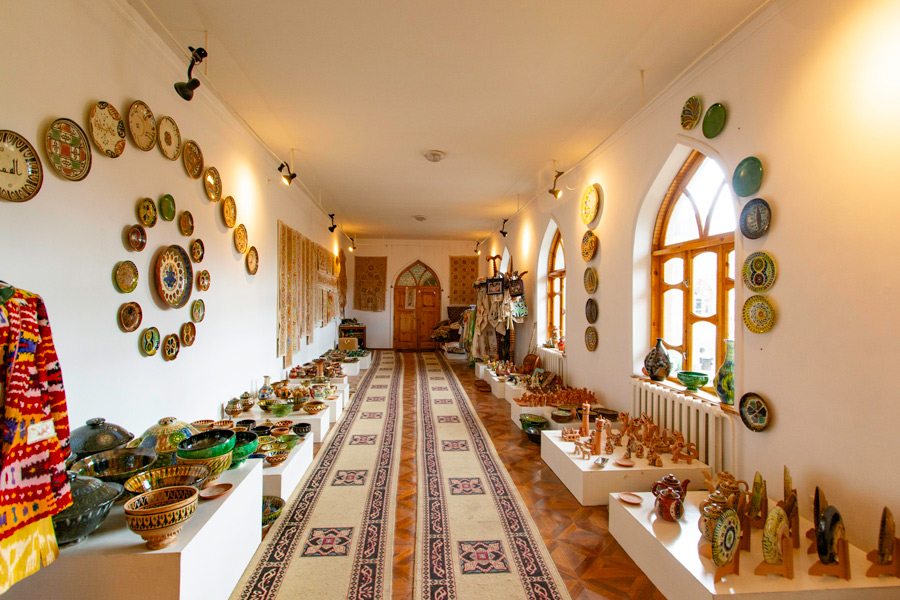
Alisher Nazrullaev (born in 1953) is a seventh-generation ceramist, an academician of the Academy of Arts of Uzbekistan, a winner of numerous awards, a participant in many international exhibitions, and one of the most renowned representatives of the Gijduvan school of ceramics.
Following His Father’s Legacy
Alisher Nazrullaev began working with ceramics as a child under the guidance of his father, Ibodullo Nazrullaev, a highly respected and widely recognized craftsman in Uzbekistan.
He received his education at the Architectural and Construction Institute in another historic city of Uzbekistan, Samarkand. After graduating in 1975, he worked for some time in the construction field but eventually chose to continue his father’s legacy, dedicating his life entirely to the art of ceramics. Since then, he has devoted himself tirelessly to creating pieces in the traditional style while also adding his own distinctive touches.
Alisher Nazrullaev has participated in exhibitions and craft fairs in Uzbekistan, Germany, France, Portugal, the USA, and other countries. In 1999, he spent six months in Japan, refining his skills in the workshop of the renowned ceramist Asakura Isokichi III (浅蔵五十吉 三代, born in 1941). In 2002, he traveled to Germany with similar goals. Through these experiences, he enriched his understanding of the craft, discovered new pottery techniques, and earned international recognition as a gifted ceramist who remains devoted to the centuries-old traditions of Uzbek craftsmanship.
He has received numerous honors, including the “Halqaro Usta” certificate awarded by the Director-General of UNESCO, the “Golden Medal” and the Prize of the President of the Republic of Uzbekistan, the honorary title of “Uzbekiston Halq Usta”, among others.
Tradition, Technique, and Color

Alisher Nazrullaev’s style continues the traditions of the Gijduvan school. The small town of Gijduvan, located near Bukhara, has long been a center of pottery. The first examples of ceramics appeared here more than a thousand years ago, around the 8th–9th centuries. During its height in the 15th–16th centuries, masters from other cities – especially from major centers like Bukhara and Samarkand – came to Gijduvan to study.
What makes Gijduvan pottery distinctive is its soft, plastic clay known as lina; a color palette dominated by browns and greens, often accented with brighter hues; and its floral and animal ornaments, with bird imagery holding particular significance. Another hallmark is the painting technique applied under a transparent glaze – after firing, the lines spread slightly, creating the blurred contours that are the most recognizable feature of the Gijduvan style.
In his work, Alisher Nazrullaev carefully follows all the stages of creating Gijduvan ceramics, from preparing the right clay himself to firing and painting. His authentic tableware, decorative pieces, and whistling toys stand out for their traditional browns and greens, combined with a freer interpretation of how the ornaments are arranged. His creations are also distinguished by original patterns with plant and animal motifs such as the “peacock flower,” “eagle’s tail,” and “white bird,” making each piece truly unique.
Eight Generations of Ceramists
The Nazrullaev dynasty of ceramists dates back to the 18th century, beginning with master craftsman Sharofiddin Gijduvoni (1790–1885). He passed his skills on to his son Usto Ergashev, who in turn shared all his knowledge with his own sons, Nazrullo Ergashev (died in 1932) and Toshem Ergashev (died in 1937). Nazrullo Ergashev was the grandfather of Alisher Nazrullaev.
Alisher Nazrullaev’s father, Ibodullo Nazrullaev (1927–1987), was a sixth-generation ceramist and one of Uzbekistan’s finest craftsmen of his time. He succeeded in preserving the nearly lost traditions of the local Gijduvan school and then passed this heritage on to his sons.
Alongside Alisher Nazrullaev, this craft was also continued by his younger brother, Abdullo Nazrullaev (born in 1963), an accomplished ceramist of international standing. Together, they represent the seventh generation of this family of masters and work side by side in the same workshop in Gijduvan. Today, the Nazrullaev dynasty has welcomed its eighth generation. Alisher Nazrullaev’s sons, Sherzodjon, Olimjon, and Obidjon Nazrullaev, are also professional ceramists, learning all the intricacies of their father’s craft.
The Nazrullaev Workshop and Museum

The Nazrullaev family workshop in Gijduvan houses a studio, the Gijduvan Ceramics Museum, and a dedicated space for master classes. This large complex offers visitors a chance to explore the history of this unique Uzbek craft – the Gijduvan school of ceramics – along with the Nazrullaev family archives, and to experience firsthand how authentic local pottery is made.
The studio regularly hosts master classes and also runs the Gijduvan Pottery School.
Discover, Create, Taste: Activities at the Workshop
When you come to the Nazrullaev house in Gijduvan, you find yourself not just in a workshop, but in a family space where everyday life and art are closely entwined. Here, pottery, embroidery, and even home cooking are part of the same quiet rhythm. Guests are welcome to look, to learn, and to share a little in this world that has grown around clay, color, and careful hands over many generations.
Visit the museum and take a pottery master class. Experience the entire process of creating ceramic tableware, from preparing and shaping the clay to working on the potter’s wheel. The master class concludes with painting, using only natural dyes, accompanied by stories about the history and unique style of Gijduvan ceramics.
Discover traditional embroidery (kashtachilik). Several generations of women in the Nazrullaev family are skilled in this art. Their intricate works, displayed in the studio, have been showcased at exhibitions both in Uzbekistan and abroad.
Join a cooking master class. By prior arrangement, you can take part in classes held at Alisher Nazrullaev’s home, where guests learn to prepare local Gijduvan dishes and enjoy another facet of this rich cultural heritage.
Visitor Information
- Address: Navoi Street, 45, Gijduvan, Bukhara Region, Uzbekistan
- Phone: +99893 4740781, +99893 3834944, +99865 5722412,
+99897 1591784, +99890 1760095 - Opening hours: everyday, 08:00 am – 08:00 pm
- Website: www.ceramicsuz.narod.ru

